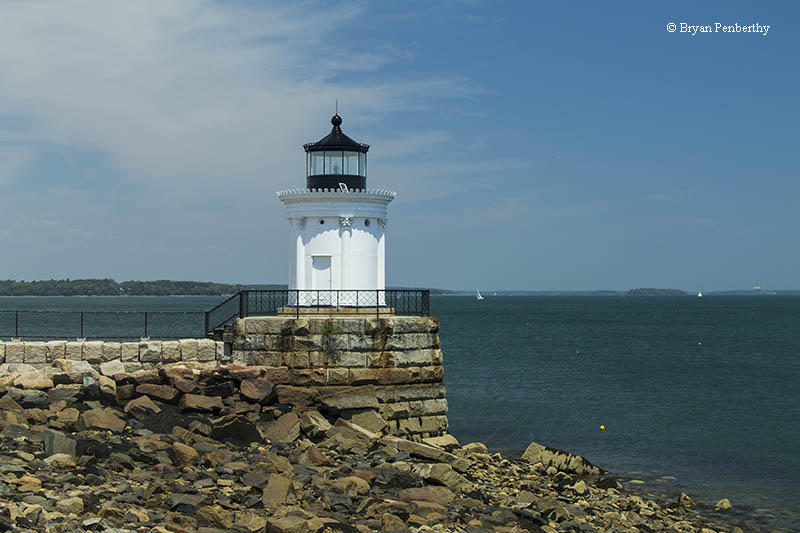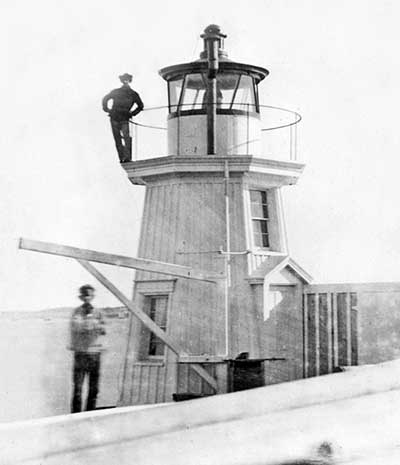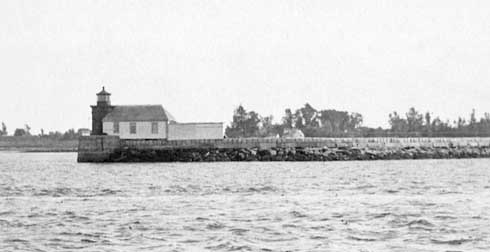Portland Breakwater Lighthouse
South Portland, Maine - 1875 (1855**)

History of the Portland Breakwater Lighthouse
Posted/Updated by Bryan Penberthy on 2016-12-29.
The first Portland Breakwater Lighthouse was erected in 1855. The breakwater lighthouse, commonly called the "Bug Light" was replaced by the current lighthouse in 1875. Today, it is the focal point of the Bug Light Park.
In November 1831, a fierce Nor'easter struck the Portland, Maine area. The storm struck at the same time as high tide, exacerbating the situation leading to widespread flooding and excessive damage to wharves and buildings.
To protect Portland Harbor from future storms, locals petitioned Congress for a protective breakwater. Congress obliged and sent the Army Topographical Engineers to survey the harbor and make recommendations for improvements.
In their 1833 report, Lieutenant Colonel John Anderson recommended a 2,500-foot, seven-part rubble stone breakwater along the southern side of the inner harbor's entrance. The estimated cost of the project was $44,417.08, which included "a beacon on the outer end of the breakwater."
On July 4, 1836, Congress appropriated $10,000, and construction started shortly thereafter under the direction of local engineer Freeman Bradford. By December, nearly one-third of the breakwater was completed. To continue the work, an additional $25,000 was appropriated on March 3, 1837 and another $26,366 on July 7, 1838.
By 1838, the breakwater had reached nearly 1,800 feet and was doing a good job protecting the harbor. Starting that year, for some reason, harbor improvement requests along the Atlantic Coast were routinely denied. As such, no additional appropriations for Portland Harbor were made. Not only was the breakwater never completed, the lighthouse at the end was never established.
What started out as a way to protect the harbor, ended up being a navigational nightmare for mariners. When approaching the harbor, vessels had to navigate a narrow passage between the end of the breakwater and Hog Island Ledge.
In 1852, the Lighthouse Board was established and charged with maintaining all aids to navigation, as well as establishing any new ones. After seeing no additional progress on completing the breakwater at Portland Harbor, the Lighthouse Board assumed it was finished.
 1855 wooden lighthouse (Courtesy Coast Guard)
1855 wooden lighthouse (Courtesy Coast Guard)
On November 22, 1853, W. B. Franklin, Lighthouse Inspector, First District, submitted the following report regarding a lighthouse for the Portland breakwater and requested $3,500:
4. Harbor light on breakwater, Portland harbor, Me. - The breakwater in this harbor is very much in the way of vessels entering the harbor, and a small light is needed on the end of it. If the board judge it necessary that a house should be built for the keeper on shore, an appropriation of $3,500 will be necessary; but if a house be not required, $1,000 will suffice. It might, perhaps, be well to have the house as a store for supplies, &c., for the light.
Congress approved the request on August 3, 1854, and by January 1855, plans were drawn up for an octagonal wooden tower with sloping wooden sides. The Lighthouse Board's plans called for the tower to have a focal plane of 25 feet above high water and to be equipped with a sixth-order Fresnel lens. Construction started that March and was completed by July 1855.
The first keeper of the lighthouse was W.A. Dyer. On August 1, 1855, he placed the tower into service displaying a fixed, red light. He served for two years before resigning. William Willard took over duties and served for three years before passing away in the line of duty. He was succeeded by B.F. Willard, his older brother.
As no keeper's house was ever built, the keepers had to traverse the breakwater to get to the tower. This proved extremely dangerous as portions of the breakwater were unfinished and had no ashlar capstone, which meant it was barely above high water. During periods of heavy weather, and during the winter when it was ice-covered, it was nearly impossible to reach the tower. Keepers sometimes had to crawl.
Due to the tower's exposed location at the end of the breakwater, it was continually wet. As the tower was made of wood, many sections were rotted and the iron was rusty. By late 1865, Colonel Graham of the Army Corps of Engineers had recommended extending the breakwater an additional 400 feet. Congress approved the $105,000 estimate, but Graham died shortly thereafter.
Brigadier General B.S. Alexander took over, but after conducting a survey of the harbor, he eliminated many of Graham's ideas. Alexander's put forth a new estimate of $60,000, but the project was held up by bureaucracy in Washington.
Although the project was still working its way through Washington, Lieutenant Colonel George Thoms took over from Alexander. While awaiting the results of study of the harbor, Thoms asked for, and received permission to cap the unfinished portions of the breakwater, thus making it safer for the keepers to reach the tower. This work was completed in 1868.
Routine maintenance was carried out over the years. In 1868, a new cast-iron smoke pipe was equipped. The following year, new clapboard siding was installed.
Construction of the breakwater extension wouldn't begin until 1872. While construction was ongoing, the wooden Portland Breakwater Lighthouse continued to function. With each passing day, the lighthouse became farther and farther from the breakwater's end. By September 1873, construction of the breakwater was complete.
Once the breakwater was complete, a temporary wooden lighthouse was established at the end and plans were made for a permanent lighthouse. On June 23, 1874, Congress appropriated $6,000 for a new cast iron tower. The following entry appeared in the Annual Report of the Secretary of the Treasury on the State of the Finances:
45. Portland Breakwater, in Portland Harbor, Maine - The temporary light-house has been removed about 150 feet in a northeasterly direction to the pier at the end of the recently-completed extension. An appropriation of $6,000 having been made at the last session of Congress for a permanent structure at this station, plans have been prepared and approved by the board, and work ordered to be commenced.
The new tower, standing 26 feet tall, was modeled after the Choragic Monument of Lysicrates, a structure built in 335 BC near Athens, Greece, and was the first known use of the Corinthian order on the exterior of a building.
The tower is unique. Surrounding the brick-lined, cast-iron tower are six, cast-iron Corinthian columns and adorning the gallery deck and the dome of the lantern are palmettes, a Greek roof edge decoration. It is unknown how the plans for this unique tower came about, but the result was a lighthouse like no other in the United States. Some suggested that Thomas Ustick Walter, who designed the cast-iron dome on the U.S. Capital building, may have designed the tower.
The lighthouse was first placed into service in June 1875 by Keeper Stephen Hubbard. Inside the lantern was a sixth-order Fresnel lens, which displayed a fixed, red light. The focal plane of the light was 30 feet above mean high water. The original wooden tower from 1855 was moved to Little Diamond Island, where it became a lookout tower at the buoy depot.
On August 1, 1878, the characteristic of the lighthouse was changed from fixed red to occulting. The light displayed a fixed red light, varied by a flash every 15 seconds. It was later changed to every 40 seconds.
The following year, an iron hand rail, 58 feet long, was built leading to the tower's entrance. By 1886, the handrail was extended all the way to shore, improving the safety of the keepers.
 Breakwater Lighthouse with dwelling (Courtesy Coast Guard)
Breakwater Lighthouse with dwelling (Courtesy Coast Guard)
Although the hand rail did help the keepers reach the tower, traversing the nearly 2,000-foot long breakwater was still dangerous. Thus, in 1889, the Lighthouse Board took steps to remedy the situation. That year, an 18-foot wide by 20-foot long addition, which contained two rooms, was attached to the tower. The following entry was in the Annual Report of the Lighthouse Board for that year:
53. Portland Breakwater, Maine - This station contained no provision for a dwelling for the keeper, and it was only accessible to him from the shore by the breakwater, which is 1,900 feet long, at much discomfort, and even peril in severe storms, when the breakwater was covered with ice. An annex to the tower containing two dwelling-rooms was therefore built. Minor repairs were made here.
In 1903, two additional rooms and an attic were added to the dwelling.
Starting on January 20, 1896, the fog bell on the Staniford Ledge buoy was removed and mounted on the Portland Breakwater Lighthouse. It remained there until May 16, 1896, when it was placed back on the buoy. It was moved each year until 1898, when it was permanently mounted on the lighthouse.
In 1899, a Stevens striking machine replaced the electric striking apparatus. Several years later, in 1903, a bell house was built and the old 400-pound fog bell was replaced by a 1,000-pound bell.
Electricity was brought to the lighthouse in 1934, and with that control of the lightstation was operated remotely from the nearby Spring Point Ledge Lighthouse. The last keeper to serve at the Portland Breakwater Lighthouse was Preston L. Marr. As the dwelling was no longer needed, it was torn down the following year in 1935.
In 1940, the Todd-Bath Iron Shipbuilding Company established a facility along the south shore, near the breakwater and lighthouse. Due to the demand of World War II, the company grew, and with that, so did their need for space. To create more space, fill was dumped into the harbor on both sides of the breakwater. All but the last 100 feet was filled in, making the tower much closer to shore.
Like most lighthouses in 1942, the light was extinguished due to World War II. Although the fog bell continued to be operated electronically for some time, the control cable was damaged during dredging operations. By May 1943, it was decided that both the lighthouse and fog bell would be discontinued.
Soon thereafter the lighthouse was declared surplus property and was sold into private ownership. The property was donated to the City of South Portland in 1985 by Al Glickman of Spring Point Associates. In 1989, funds were secured allowing for renovations, including structural repairs and a new coat of paint.
The lighthouse continued to deteriorate throughout the 1990s. A new restoration was undertaken by the South Portland-Cape Elizabeth Rotary Club and the Spring Point Ledge Light Trust that concluded with a relighting ceremony on August 14, 2002.
Today, the lighthouse is the focal point of the Bug Light Park. To welcome mariners to Portland Harbor, the tower displays a white flash every four seconds. The park also contains the Liberty Ship Memorial commemorating the roughly 30,000 people that were employed to build ships for the war effort.
Reference:
- Annual Report of the Light House Board, U.S. Lighthouse Service, Various years.
- Lighthouses of Maine, Bill Caldwell, 1986.
- The Lighthouses of Maine: Southern Maine and Casco Bay, Jeremy D'Entremont, 2013.
- "The Portland Breakwater Light Station," Wayne Wheeler, The Keeper's Log, Spring 2004.
Directions: While in South Portland, follow Broadway Street north until the intersection with Benjamin W. Pickett Street / Breakwater Drive. Turn left onto Breakwater Drive, which then turns into Madison Street. Follow Madison Street to the end, which is Bug Light Park. The lighthouse will be at the end of the breakwater.
Access: The lighthouse is owned by the City of South Portland. Grounds open, tower closed.
View more Portland Breakwater Lighthouse picturesTower Height: 26.00'
Focal Plane: 30'
Active Aid to Navigation: Deactivated (1942)
*Latitude: 43.65550 N
*Longitude: -70.23485 W
See this lighthouse on Google Maps.
